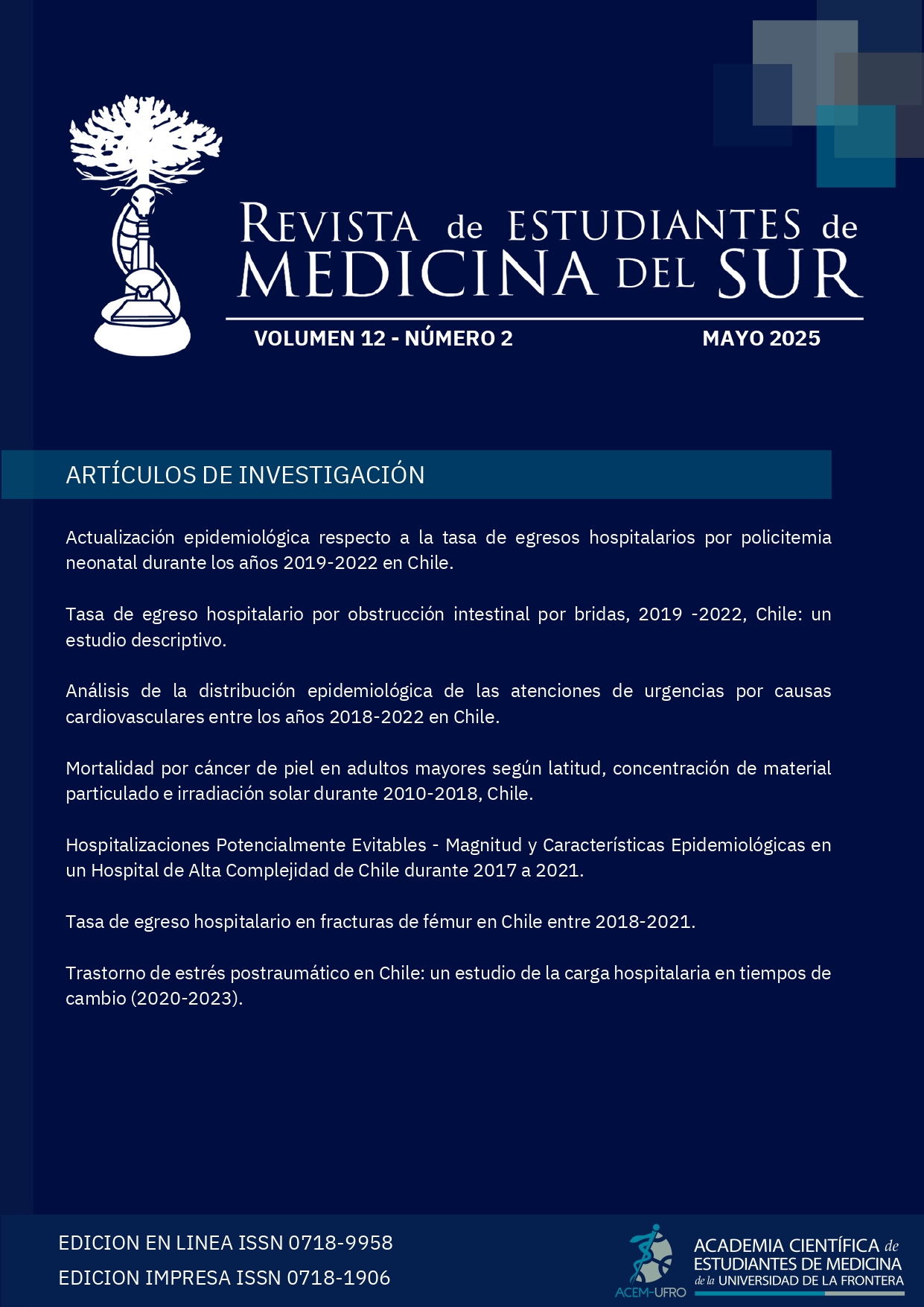Tasa de egreso hospitalario en fracturas de fémur en Chile entre 2018-2021
Characterization of femoral fractures hospital discharge rate in Chile between 2018-2021
DOI:
https://doi.org/10.56754/0718-9958.2025.226Keywords:
Fractura Femoral, Egreso Hospitalario, ChileAbstract
Introduction: Femoral Fractures (FF) are a frequent cause of emergency department visits. FF can be anatomically classified, and its relationship with factors such as age, sex, trauma mechanism, comorbidities, among others, have been described. Currently, there are no studies in Chile that describe the complete and updated national epidemiology.
Material and methods: This ecological descriptive study describes the hospital discharge rate (HDR) of FF per 100,000 inhabitants by sex, age group, and type of FF (ICD-10) between 2018-2021 in Chile (N=46,355). Descriptive statistics were used to calculate the HDR. Ethical committee approval was not required.
Results: The HDR was calculated at 65.94 per 100,000 inhabitants between 2018-2021, with the highest rate in 2018 at 68.04. The HDR for females and males was 84.79 and 46.28, respectively. The age group with the highest HDR was 80 and above, with 1190.32. The most common type of FF was Neck (S72.0), followed by Unspecified (S72.9), and Pertrochanteric (S72.1) in third place.
Discussion: The HDR trend is decreasing compared to other studies, indicating the impact of the COVID-19 pandemic. This may be associated with the use of the Unspecified classification (S72.9), which involves an initial underdiagnosis of other types of FF. The trends in age, sex, and type of FF align with the existing literature.
Keywords: Femoral Fractures, Patient Discharge, Chile
References
Yuan H, Yu H, Zhu Y, Xiang L, Wang H. Effect of age on the patterns of traumatic femoral fractures: Seven years of experience at a regional tertiary hospital. Orthop Surg. 2022;14(9):2132–40. Disponible en: http://dx.doi.org/10.1111/os.13410
Wu S-C, Rau C-S, Kuo SCH, Chien P-C, Hsieh C-H. The influence of ageing on the incidence and site of trauma femoral fractures: a cross-sectional analysis. BMC Musculoskelet Disord. 2019;20(1):413. Disponible en: http://dx.doi.org/10.1186/s12891-019-2803-x
Meinberg EG, Agel J, Roberts CS, Karam MD, Kellam JF. Fracture and dislocation classification compendium—2018. J Orthop Trauma. 2018;32(1):S1–10. Disponible en: http://dx.doi.org/10.1097/bot.0000000000001063
Denisiuk M, Afsari A. Femoral Shaft Fractures. [Updated 2023 Jan 2]. In: StatPearls [Internet]. Treasure Island (FL): StatPearls Publishing; 2023 Jan-. Available from: https://www.ncbi.nlm.nih.gov/books/NBK556057/
Lundin N, Huttunen TT, Enocson A, Marcano AI, Felländer-Tsai L, Berg HE. Epidemiology and mortality of pelvic and femur fractures—a nationwide register study of 417,840 fractures in Sweden across 16 years: diverging trends for potentially lethal fractures. Acta Orthop. 2021;92(3):323–8. Disponible en: http://dx.doi.org/10.1080/17453674.2021.1878329.
Lim S-J, Yeo I, Yoon P-W, Yoo JJ, Rhyu K-H, Han S-B, et al. Incidence, risk factors, and fracture healing of atypical femoral fractures: a multicenter case-control study. Osteoporos Int. 2018;29(11):2427–35. Disponible en: http://dx.doi.org/10.1007/s00198-018-4640-4.
Tanha K, Fahimfar N, Nematollahi S, Sajjadi-Jazi SM, Gharibzadeh S, Sanjari M, et al. Annual incidence of osteoporotic hip fractures in Iran: a systematic review and meta-analysis. BMC Geriatr. 2021;21(1). Disponible en: http://dx.doi.org/10.1186/s12877-021-02603-1.
Amblàs-Novellas J, Martori JC, Molist Brunet N, Oller R, Gómez-Batiste X, Espaulella Panicot J. Índice frágil-VIG: diseño y evaluación de un índice de fragilidad basado en la Valoración Integral Geriátrica. Rev Esp Geriatr Gerontol. 2017;52(3):119–27. Disponible en: http://dx.doi.org/10.1016/j.regg.2016.09.003.
Badosa-Collell G, Latorre-Vallbona N, Martori JC, Oller R, Trullàs JC, Amblàs-Novellas J. Capacidad predictiva de mortalidad del índice Frágil-VIG (IF-VIG) en pacientes ancianos con fractura de fémur. Rev Esp Geriatr Gerontol. 2022;57(4):220–3. Disponible en: http://dx.doi.org/10.1016/j.regg.2022.05.002.
Fischer H, Maleitzke T, Eder C, Ahmad S, Stöckle U, Braun KF. Management of proximal femur fractures in the elderly: current concepts and treatment options. Eur J Med Res. 2021;26(1):86. Disponible en: http://dx.doi.org/10.1186/s40001-021-00556-0.
Williamson S, Landeiro F, McConnell T, Fulford-Smith L, Javaid MK, Judge A, et al. Costs of fragility hip fractures globally: a systematic review and meta-regression analysis. Osteoporos Int. 2017;28(10):2791–800. Disponible en: http://dx.doi.org/10.1007/s00198-017-4153-6.
Meagher E, Varghese S, Harty JA, O’Loughlin PF. The decline of hip fracture incidence rates over a 10-year period: A single centre experience. Injury. 2021;52(7):1807–12. Disponible en: http://dx.doi.org/10.1016/j.injury.2021.04.051.
Ormeño JC, Martínez R, Frías C, Von Plessing C, Quevedo I. Decreasing hip fracture rates among older adults in Chile, 2001–2019. Arch Osteoporos. 2022;17(1). Disponible en: http://dx.doi.org/10.1007/s11657-022-01067-z.
Series Estadísticas del Sistema Isapre 1990-2021 - Series Estadísticas del Sistema Isapre 1990-2021. Biblioteca digital. Superintendencia de Salud. Gobierno de Chile. Disponible en: http://www.supersalud.gob.cl/documentacion/666/w3-article-21625.html.
Veronese N, Maggi S. Epidemiology and social costs of hip fracture. Injury. 2018;49(8):1458–60. Disponible en: http://dx.doi.org/10.1016/j.injury.2018.04.015.
Departamento de Epidemiología, MINSAL. Encuesta Nacional de Salud 2016-2017. 2017.
Díaz AR, Navas PZ. Risk factors for trochanteric and femoral neck fracture Revista Española de Cirugía Ortopédica y Traumatología. 2018;62:134–41.
Barron RL, Oster G, Grauer A, Crittenden DB, Weycker D. Determinants of imminent fracture risk in postmenopausal women with osteoporosis. Osteoporos Int. 2020;31(11):2103–11. Disponible en: http://dx.doi.org/10.1007/s00198-020-05294-3.
Barahona M, Martínez Á, Brañes J, Rodríguez D, Barrientos C. Incidence, risk factors and case fatality rate for hip fracture in Chile: A cross-sectional study based on 2017 national registries. Medwave. 2020;20(5):e7939. Disponible en: http://dx.doi.org/10.5867/medwave.2020.05.7939.
Yoo J-I, Kim H, Ha Y-C, Kwon H-B, Koo K-H. Osteosarcopenia in patients with hip fracture is related with high mortality. J Korean Med Sci. 2018;33(4). Disponible en: http://dx.doi.org/10.3346/jkms.2018.33.e27.
Pech-Ciau BA, Lima-Martínez EA, Espinosa-Cruz GA, Pacho-Aguilar CR, Huchim-Lara O, Alejos-Gómez RA. Fractura de cadera en el adulto mayor: epidemiología y costos de la atención. Acta Ortop Mex. 2021;35(4):341–7. Disponible en: http://dx.doi.org/10.35366/103314.
Almansouf AS, Alkhanbashi OK, Alsumairi S, Alhussein NA, Alosaimi M, Alquraishi AA, et al. The prevalence of pediatric lower limb fractures following motor vehicle accidents at king Abdullah specialist children’s hospital, Riyadh, Saudi Arabia. Cureus. 2022; Disponible en: http://dx.doi.org/10.7759/cureus.28724.
Salonen A, Laitakari E, Berg HE, Felländer-Tsai L, Mattila VM, Huttunen TT. Incidence of femoral fractures in children and adolescents in Finland and Sweden between 1998 and 2016: A binational population-based study. Scand J Surg. 2022;111(1):145749692210831. Disponible en: http://dx.doi.org/10.1177/14574969221083133.
CONASET. Estadísticas Generales. Disponible en: https://www.conaset.cl/programa/observatorio-datos-estadistica/biblioteca-observatorio/estadisticas-generales/.
Downloads
Published
How to Cite
Issue
Section
Categories
License
Copyright (c) 2025 Ignacio Echeverria, Abdias Cofré, Gonzalo Monroy, Ricardo Muñoz

This work is licensed under a Creative Commons Attribution-NonCommercial-ShareAlike 4.0 International License.


